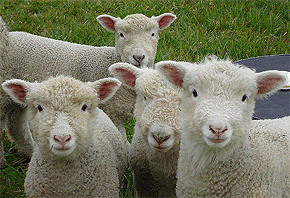
By Allan Barber
 Beef and Lamb New Zealand’s Economic Service has completed its annual stock survey which shows that numbers have recovered and stabilised from the low levels reached last year.
Beef and Lamb New Zealand’s Economic Service has completed its annual stock survey which shows that numbers have recovered and stabilised from the low levels reached last year.
Last year’s 4.4% reduction in sheep numbers to an all time low has increased by 2.6%, although most of the increase arises from a 10% increase in ewe hoggets, while ewe numbers have only lifted by 120,000 from the low of 20.49 million, the record low since the early years of the 20th century.
The retained ewe hoggets are expected to be slaughtered in the July/September quarter. However the good growing season means ewes are in good condition and scanning indicates that in-lamb ewes are carrying 5-10% more lambs than last year.
Provided adverse weather doesn’t cause larger than anticipated lamb losses, there is every reason to expect 1 million (5%) more lambs on the ground.
There could also be an increase in lambing percentage over the previous record of 123% achieved in 2009-10; and for every percentage improvement in lambing percentage, there will be another 200,000 lambs tailed.
This of course will prompt the question as to whether the markets can absorb the extra lambs, given the flat state of most overseas economies and the significant amount of inventory clogging up the pipeline.
Past experience suggests that the pipeline is already starting to free up, so buyers will start to place orders again in the not too distant future.
In addition the growth last season meant that farmers held back stock and continued to put weight on.
At the same time meat exporters failed to give the right market signals soon enough, because they had to keep prices high to secure throughput.
Assuming the law of climatic averages reasserts itself, the coming season will return to more normal conditions. Therefore the conflicting messages of procurement and market price will not be so far out of kilter again and supply and demand will be more complementary.
If not, we will have to pray for an outbreak of rational behaviour from producers and processors.
Unlikely I hear you say.
Beef cattle rose 1% to 3.88 million nationally and 3.6% in the North Island because of increases in the cow herd and beef weaners
Conversely cattle numbers decreased by 5.7% in the South Island because of dairy grazing and conversions, combined with fewer cattle on hand at the end of June because of the good growing conditions.
Unlike the sheep situation in the North Island which allowed farmers to hold onto their sheep, South Island beef cattle producers were able to get their cattle up to weight and off the property earlier.
The dairy herd increased by 3.2%, notably because of the amount of older cows held over in the North Island because of the high dairy payout. These will certainly head for slaughter next year and, unless the drought in the United States causes an excess of US beef, the production will find a ready market at stable prices.
The changing nature of land use in New Zealand can be seen from the fact that the North Island is now home to more sheep than the South Island for the first time in living memory.
At the same time the South Island, assisted by irrigation, now has 35% of the country’s dairy cows, a proportion which was inconceivable 15 years ago.
--------------------------------------------
Allan Barber is a commentator on agribusiness, especially the meat industry, and lives in the Matakana Wine Country where he runs a boutique B&B with his wife. You can contact him by email at allan@barberstrategic.co.nz or read his blog here »
1 Comments
SFF, think it could be a million too many, the one that broke the camels back.
Keith@silverfernfarms.co.nz to me Good eveningAs a business we have responsibilities to a range of stakeholders, not the least our shareholder-suppliers.
The current procurement pricing environment creates a position where we do not recover even the cost of processing let alone overheads.
Whilst we supply a number of markets where we do make a margin, these markets require a limited volume of stock, which we are buying on the spot market or sourcing from our term Backbone supply contracts.
We appreciate others may be offering higher spot prices, which is their prerogative and reflects their own positions.
We, however, do not believe we are mandated to ignore the realities of the marketplace and the new highs of currency, which would see us sending the wrong pricing signals to suppliers, and worse, disrupting the store market and effectively subsidising winter procurement pricing from main season procurement.
We understand suppliers will make choices on the back of our decision to reduce our processing capacity to a bare minimum for the balance of winter, to serve key global customers and limit the volume of livestock required.
However, we are here for the long haul; we believe it is incumbent on us to act responsibly and in the long term interests of our shareholders, suppliers and customers, rather than fuel and further distort the livestock market.
We trust this gives you some clarity to our position.
Regards
Keith

We welcome your comments below. If you are not already registered, please register to comment
Remember we welcome robust, respectful and insightful debate. We don't welcome abusive or defamatory comments and will de-register those repeatedly making such comments. Our current comment policy is here.